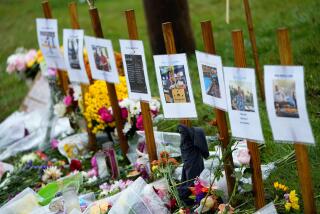Defining the time to kill
- Share via
CAMP PENDLETON — The war-crime hearings underway here have led to an unusual public airing of some of the Marine Corps’ most tightly held combat secrets: the so-called rules of engagement that govern when Marines can use deadly force in Iraq.
Testimony thus far suggests the rules are ambiguous and subjective, and leave many Marines feeling they are being hamstrung in their ability to protect themselves by killing or capturing the enemy.
In the Haditha cases, where enlisted Marines are charged with murder, defense attorneys assert their clients were following the rules of engagement when they shot 24 Iraqi civilians, including women and children, minutes after a fellow Marine was killed by a roadside bomb in November 2005. Five were pulled from a taxi and killed, and 19 were killed in three nearby houses.
Prosecutors, with equal conviction, say the Marines were violating the same rules. The hearing officer said he’s confused about what the rules permit.
The rules of engagement are so central to Marine culture that they are treated as a closely held secret. During hearings in other cases, the courtroom has been cleared while evidence about the rules has been discussed. Reporters who travel with Marine battalions have to sign an agreement not to disclose such rules.
Boiled down, the rules require a four-step process before Marines can fire their M-16s: show, shout, shove and then shoot. A Marine must also have positive identification of a target as a threat. A target must have shown not just a hostile intent but also hostile actions.
But the definitions of positive identification, hostile intent and hostile action are subjective, and thus can change from one area to the next, one day to the next, according to testimony.
In the Hamandiya case, defendants are accused of kidnapping and killing an unarmed Iraqi man in April 2006, then planting a shovel and assault rifle near his body to make it look like he was an insurgent planting a bomb.
Testimony by one of their officers in that case suggests frustration with the rules of engagement may have led the Marines to look to a B-grade Hollywood movie for a tactical solution.
A platoon lieutenant testified that one night while on a fruitless ambush mission, his Marines started talking about the 1999 movie “The Boondock Saints,” in which young men in Boston begin killing the gangsters that are terrorizing their neighborhood and seem beyond the reach of the law.
The movie’s message was clear: The killings weren’t legal, but they were morally justified.
A couple of nights later, a squad of Marines led by Sgt. Lawrence Hutchins III allegedly carried out a plot to kidnap and execute a suspected insurgent leader in Hamandiya as a warning to other Iraqis to stop attacking Marines. Hutchins faces murder charges.
The lieutenant, who testified in the Hamandiya case Friday, said he was unaware of the plot but added that on other occasions, he had ordered tactics not mentioned in the rules of engagement, like choking suspects and putting a gun in one suspect’s mouth until he provided information about planned insurgent attacks.
“It was a gray area,” said 2nd Lt. Nathan Phan, “and I thought I was doing the right thing to get information to save Marines’ lives.”
The judge, hearing testimony from Phan and defense witnesses, told the defense attorneys that their case seemed to be based on the assertion that the rules of engagement “are tying our hands up and people are laughing at us.”
In the Haditha cases, where enlisted Marines killed numerous civilians during a raid, the hearing officer, Lt. Col. Paul Ware, has repeatedly expressed exasperation at testimony about the rules of engagement.
Capt. Kathryn Navin, a lawyer who briefs Marines in Iraq before they go into combat, testified that it is permissible to shoot and kill people fleeing a roadside bomb attack even if they are unarmed and no proof exists that they were involved in the attack.
But, Navin added, it is not necessarily permissible to kill someone just for pointing a gun at you.
“So the [rules of engagement] are more restrictive than the common law, where [a civilian] can kill someone who points a gun at you?” Ware asked with a note of incredulity.
Capt. Jeffrey Dinsmore, who was the battalion intelligence officer when Marines killed 24 civilians in Haditha, testified that there is continuing conflict between frontline Marines and upper-level officers about what constitutes positive identification and what behavior defines hostile action.
In the preliminary hearing of Lance Cpl. Stephen B. Tatum, prosecutors assert that, under the rules of engagement, he had a responsibility to identify his targets as threats before firing. Tatum is accused of killing six unarmed civilians in Haditha, including women and children.
“Marines are required to positively identify a target, even a house that is considered hostile,” said Lt. Col. Paul Atterbury, the lead prosecutor. “Is it challenging? Yes. Unfortunately that’s the reality we have.”
But Tatum’s lawyer, Jack Zimmerman, said Tatum was following the most important rule of all -- coming to the aid of other Marines, who were firing at targets inside the house.
“You cannot sit back in this air-conditioned room at Camp Pendleton and second-guess these young men,” Zimmerman told Ware.
Ware will make a recommendation to Lt. Gen. James N. Mattis on whether Tatum should go to court-martial. He has already recommended that Lance Cpl. Justin L. Sharratt not be court-martialed.
One of the thornier issues about rules of engagement concerns firing at houses where insurgents may be hiding behind civilians. In their pre-combat lecture, Marines are told that once a house has been declared “hostile,” it is permissible to fire on it.
But a Pentagon law-of-war expert, W. Hays Parks, said, “The fact that [the insurgents] use human shields doesn’t give us authority to start firing and say, ‘The fault is yours, not ours.’ ” Parks was testifying in the case of Lt. Col. Jeffrey Chessani, accused of dereliction of duty for not investigating the Haditha killings.
But looser rules seem to apply when a decision is made to use air power. Testimony suggests that civilian casualties are expected, and tolerated, when a decision is made to drop a bomb or fire a missile at a “high-profile” target rather than send in ground troops.
“You can declare [Al Qaeda in Iraq leader Abu Musab] Zarqawi hostile and drop a bomb on the house and kill him and everybody in the house,” said Lt. Col. Brian Cosgrove, one of Hutchins’ attorneys.
After they receive lectures in Camp Pendleton and Iraq, Marines are given small cards summarizing the rules of engagement to keep in their pockets.
Marines called as character witnesses for the defendants have made no reference to whether they are judged fit for combat based on their knowledge and obedience to the rules of engagement. Rather, a Marine’s dedication to helping colleagues survive appears to take precedence.
“He’s a good noncommissioned officer,” Capt. William Diaz testified about Cpl. Trent D. Thomas. “Good NCOs are hard to find. He would get his Marines home alive; that’s the primary thing.”
Thomas, making an unsworn statement to the same jury, said, “Every Marine I ever served with knows Cpl. Thomas has his back.”
The jury, which had convicted Thomas of kidnapping and conspiracy to commit murder in the Hamandiya plot, decided not to sentence him to additional time in the brig beyond the 14 months he spent behind bars awaiting his trial.
Navin testified that Marines are given a 70-slide lecture on the rules before being sent to the front lines. The final slide in the formal lecture shows a cartoon of an Arab figure, riding a camel and waving a sword, who has just lopped off the nose of a fighter jet on the ground.
The pilot asks, “What are the rules of engagement?”
More to Read
Sign up for Essential California
The most important California stories and recommendations in your inbox every morning.
You may occasionally receive promotional content from the Los Angeles Times.










